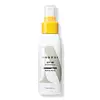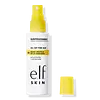What's inside
What's inside
 Key Ingredients
Key Ingredients

 Benefits
Benefits

 Concerns
Concerns

 Ingredients Side-by-side
Ingredients Side-by-side

Butyl Methoxydibenzoylmethane 2%
UV AbsorberHomosalate 9%
Skin ConditioningEthylhexyl Salicylate 4.5%
UV AbsorberOctocrylene 2%
UV AbsorberAlcohol Denat.
AntimicrobialIsododecane
EmollientButyloctyl Salicylate
Skin ConditioningPvp
Emulsion StabilisingParfum
MaskingBenzyl Benzoate
AntimicrobialEthylcellulose
Sodium Acetate
BufferingGlycine Soja Oil
EmollientPolyglyceryl-3 Diisostearate
EmulsifyingOryza Sativa Extract
AbsorbentOryza Sativa Germ Extract
EmollientWater
Skin ConditioningGlycerin
HumectantCereus Grandiflorus Flower Extract
Skin ConditioningPotassium Sorbate
PreservativePhenoxyethanol
PreservativeCitric Acid
BufferingSodium Benzoate
MaskingTropaeolum Majus Flower/Leaf Extract
RefreshingEthylhexylglycerin
Skin ConditioningButyl Methoxydibenzoylmethane 2%, Homosalate 9%, Ethylhexyl Salicylate 4.5%, Octocrylene 2%, Alcohol Denat., Isododecane, Butyloctyl Salicylate, Pvp, Parfum, Benzyl Benzoate, Ethylcellulose, Sodium Acetate, Glycine Soja Oil, Polyglyceryl-3 Diisostearate, Oryza Sativa Extract, Oryza Sativa Germ Extract, Water, Glycerin, Cereus Grandiflorus Flower Extract, Potassium Sorbate, Phenoxyethanol, Citric Acid, Sodium Benzoate, Tropaeolum Majus Flower/Leaf Extract, Ethylhexylglycerin
Butyl Methoxydibenzoylmethane 2.9%
UV AbsorberEthylhexyl Salicylate 4.9%
UV AbsorberOctocrylene 9.5%
UV AbsorberAlcohol Denat.
AntimicrobialButyloctyl Salicylate
Skin ConditioningIsododecane
EmollientDiisooctyl Succinate
EmollientDiheptyl Succinate
EmollientSilica Caprylyl Silylate
Dicaprylyl Carbonate
EmollientHelianthus Annuus Seed Oil
EmollientCitrullus Lanatus Fruit Extract
Skin ConditioningOpuntia Ficus-Indica Seed Oil
EmollientBisabolol
MaskingPvp
Emulsion StabilisingCapryloyl Glycerin/Sebacic Acid Copolymer
Skin ConditioningEthyl Ferulate
AntioxidantTocopherol
AntioxidantBeta-Sitosterol
Emulsion StabilisingSqualene
EmollientNylon-12
Lauroyl Lysine
Skin ConditioningButyl Methoxydibenzoylmethane 2.9%, Ethylhexyl Salicylate 4.9%, Octocrylene 9.5%, Alcohol Denat., Butyloctyl Salicylate, Isododecane, Diisooctyl Succinate, Diheptyl Succinate, Silica Caprylyl Silylate, Dicaprylyl Carbonate, Helianthus Annuus Seed Oil, Citrullus Lanatus Fruit Extract, Opuntia Ficus-Indica Seed Oil, Bisabolol, Pvp, Capryloyl Glycerin/Sebacic Acid Copolymer, Ethyl Ferulate, Tocopherol, Beta-Sitosterol, Squalene, Nylon-12, Lauroyl Lysine
 Reviews
Reviews

Ingredients Explained
These ingredients are found in both products.
Ingredients higher up in an ingredient list are typically present in a larger amount.
Alcohol Denat. is an alcohol with a denaturant property. It is created by mixing ethanol with other additives.
This ingredient gets a bad rep because it is irritating and drying - mostly due to its astringent property. Astringents draw out natural oils in tissue, constricting pores and leaving your skin dried out.
However, alcohol denat. is not all that bad.
Due to its low molecular weight, alcohol denat. tends to evaporate quickly. One study on pig skin found half of applied alcohol evaporated in 10 seconds and less than 3% stayed on skin.
This also helps other ingredients become better absorbed upon application.
Studies are conflicted about whether this ingredient causes skin dehydration. One study from 2005 found adding emollients to propanol-based sanitizer decreased skin dryness and irritation. Another study found irritation only occurs if your skin is already damaged.
Small amounts of alcohol are generally tolerated by oily skin or people who live in humid environments.
The rule of thumb is if this alcohol is near the end of an ingredients list, it will probably not affect your skin much.
Also...
This ingredient has antimicrobial and solvent properties.
The antimicrobial property helps preserve products and increase their shelf life. As a solvent, it helps dissolve other ingredients.
Other types of astringent alcohols include:
Learn more about Alcohol Denat.Also known as Avobenzone, this ingredient is a chemical sunscreen filter that provides protection in the UV-A range.
Avobenzone is globally approved and is the most commonly used UV-A filter in the world.
Studies have found that avobenzone becomes ineffective when exposed to UV light (it is not photostable; meaning that it breaks down in sunlight). Because of this, formulations that include avobenzone will usually contain stabilizers such as octocrylene.
However, some modern formulations (looking at you, EU!) are able to stabilize avobenzone by coating the molecules.
Avobenzone does not protect against the UV-B range, so it's important to check that the sunscreen you're using contains other UV filters that do!
The highest concentration of avobenzone permitted is 3% in the US, and 5% in the EU.
Learn more about Butyl MethoxydibenzoylmethaneButyloctyl Salicylate is a chemical UV filter structurally similar to octisalate. It is a photostabilizer, SPF booster, emollient and solvent. This ingredient helps evenly spread out ingredients.
According to a manufacturer, it is suitable for pairing with micro Titanium Dioxide, Zinc Oxide, and pigments.
Photostabilizers help stabilize UV-filters and prevents them from degrading quickly.
Learn more about Butyloctyl SalicylateEthylhexyl Salicylate is an organic compound used to block UV rays. It primarily absorbs UVB rays but offers a small amount of UVA protection as well.
Commonly found in sunscreens, Ethylhexyl Salicylate is created from salicylic acid and 2-ethylhexanol. You might know salicylic acid as the effective acne fighter ingredient and BHA.
The ethylhexanol in this ingredient is a fatty alcohol and helps hydrate your skin, similar to oils. It is an emollient, which means it traps moisture into the skin.
According to manufacturers, Ethylhexyl Salicylate absorbs UV wavelength of 295-315 nm, with a peak absorption at 307-310 nm. UVA rays are linked to long term skin damage, such as hyperpigmentation. UVB rays emit more energy and are capable of damaging our DNA. UVB rays cause sunburn.
Learn more about Ethylhexyl SalicylateIsododecane is a fragrance, emollient, and solvent.
As an emollient, it helps your skin stay soft and hydrated. Emollients help trap moisture into your skin.
Isododecane's role as a solvent makes it a great texture enhancer. It spreads smoothly on skin and does not leave a sticky feeling behind. Isododecane also helps prevent color transfer in makeup products.
Isododecane is not absorbed into skin.
Learn more about IsododecaneOctocrylene protects skin from sun damage. It absorbs UV-B with peak absorption of 304 nm. It is a common sunscreen ingredient and often paired with avobenzone, a UVA filter. This is because octocrylene stabilizes other sunscreen ingredients by protecting them from degradation when exposed to sunlight. Octocrylene is a photostable ingredient and loses about 10% of SPF in 95 minutes.
Octocrylene also acts as an emollient, meaning it helps skin retain moisture and softens skin. It is oil-soluble and hydrophobic, enhancing water-resistant properties in a product.
Those who are using ketoprofen, a topical anti-inflammatory drug, may experience an allergic reaction when using octocrylene. It is best to speak with a healthcare professional about using sunscreens with octocrylene.
The EU allows a maximum of these concentrations:
Learn more about OctocrylenePvp is a water-soluble synthetic polymer and common hairstyling ingredient. It is a film-forming ingredient and used to "hold" specific shapes of hair.
Pvp is less effective in high-humidity. It tends to draw moisture, but this moisture dismantles the structure and "hold".